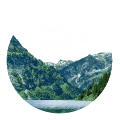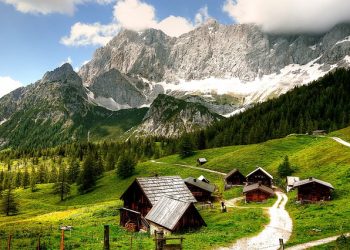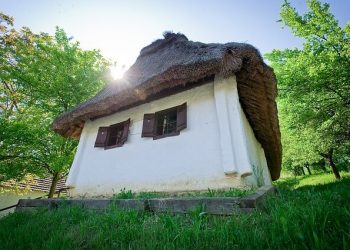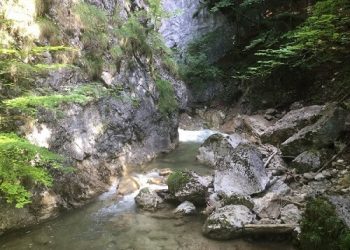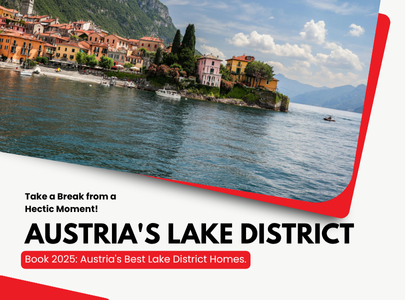Graz is located in southern Austria, not far from the border with Slovenia. It is a very large city by Austrian standards, with about 300,000 inhabitants. The city’s name comes from the Slavic word “Gradec,” which means “small castle.”
The city center is filled with ancient buildings and special narrow streets. There’s something charming about Graz’s Old Town, and it’s no wonder it’s a UNESCO World Heritage site.
The city offers a wonderful combination of new and old, ancient and modern. It has plenty of activities and a youthful vibe thanks to its many universities, which attract numerous students from all over Austria and abroad.
In this article, we have gathered the most important information for planning your visit to the city.
- The Story of the City
- The Jewish Community of Graz
- The Old Town
- The Castle Hill and Clock Tower
- Graz Castle and the Double Spiral Staircase
- Eggenberg Palace
- Murinsel – Island on the Mur River
- Main Museums
- The Graz Armoury
- The Graz Art Museum
- Arnold Schwarzenegger Museum
- Recommended Hotels in Graz
- Shopping in Graz
- Public Transportation
- The Weather
- How to Get from Vienna to Graz Quickly by Public Transport
- Other Essential Information
The Story of Graz
The city of Graz began as a small village in the Middle Ages on the ruins of an ancient settlement near the Mur River. The small village began to grow and prosper in the 12th century when it was under the rule of the House of Babenberg and later under the rule of the House of Habsburg. Graz’s location was very central during the Holy Roman Empire, and it served as an excellent place to control the adjacent areas of the empire.
From the 14th century, several members of the Habsburg family lived in the Schlossberg (Castle Hill) in the city, from which they ruled over “Inner Austria,” which included Styria, Carinthia, Slovenia, and Italy. The members of the noble family continued to live in the city until the fall of the empire.
In the 15th and 16th centuries, the area was under repeated attacks. First, the Hungarian army invaded the area, and later the Ottoman army reached the outskirts of the city. Besides the fortified Riegersburg Castle, the Schlossberg castle also never fell in battle with the invading armies.
Only Napoleon’s army managed to take control of the city at the beginning of the 19th century, after the emperor ordered a total surrender when Vienna was under heavy attack. After Austria’s surrender and according to the agreement signed at Schönbrunn Palace in 1809, the fortified Schlossberg was largely destroyed.
Graz was greatly influenced by nearby Italy and Slovenia. Many buildings in the city were designed in the Italian Renaissance style, and many Slovenes lived there. In fact, for many years, Graz was more important to the Slovenes than the city of Ljubljana.
At the beginning of World War II, the city’s residents welcomed Hitler with open arms and took an active part in implementing and entrenching the Nazi ideology. The Jews suffered greatly during this period. Some managed to escape, and some were sent to concentration and extermination camps. During the war, the city was under heavy bombing by Allied aircraft, and about 15% of its buildings were destroyed.
After the war, the city slowly began to recover and once again became an important Austrian center. The Old Town center, which was barely damaged in the war, is considered one of the best-preserved city centers in Central Europe.
Today, Graz is considered a relatively young and dynamic city, with about 60,000 students studying in its 6 universities.
The Jewish Community of Graz
Jews have lived in this area since the Middle Ages but suffered for many years from decrees against them. For hundreds of years, they were forbidden to settle permanently in the area and participate in trade. Only in the mid-19th century were Jews allowed to stay in Graz temporarily. In 1867, Jews received full equal rights throughout Austria, and the Jewish community was officially established in 1869. Initially, the community had about 250 members, but by 1880 it had 1,200 members. The first synagogue was established in 1892, and at the same time, a wide variety of Jewish institutions were established in Graz and its surrounding towns. In 1932, there were about 2,500 Jews in the Graz area.
In 1938, immediately after the annexation of Austria to Germany under Nazi rule, riots began against the Jews. Jewish shops were vandalized, and the synagogue, community offices, and the ceremonial hall at the Jewish cemetery were set on fire. Some of the Jews who lived in the city managed to escape and immigrate to Israel, while others were arrested and sent to concentration and extermination camps. In 1940, the city of Graz was declared “free of Jews.”
After the war, a few dozen survivors returned and re-established the destroyed community. During this period, a small prayer house and a ceremonial hall at the cemetery were established. In 2000, the construction of the central synagogue of Graz was completed.
The synagogue building is very modern and can be easily identified by the giant glass dome on its top. The Jewish community continues to exist to this day and has several dozen Jewish members who live in the city and nearby towns. On holidays and Sabbaths, prayers are held in the synagogue, and sometimes community meals are held.
- Official Website (German)
- Email: office@juedischegemeindegraz.at
- Synagogue Address: David Herzog Platz 1
- Map
The Old Town of Graz
One of the most touristy places in Graz is, of course, the Old Town area. The city center, a UNESCO World Heritage site, is undoubtedly a very special place. The narrow streets and numerous ancient buildings give the Old Town a very picturesque look. The influence of the Italian building style is evident in the diverse buildings found in this area.
The best way to get an impression of the Old Town is to simply walk along the main pedestrian street (Herrengasse) past beautiful shops and magnificent buildings like the “Painted House” (Gemaltes Haus) from the 18th century, decorated with spectacular murals. From the main pedestrian street, you can enter the side alleys between the ancient buildings and pass through well-kept courtyards and ancient squares.
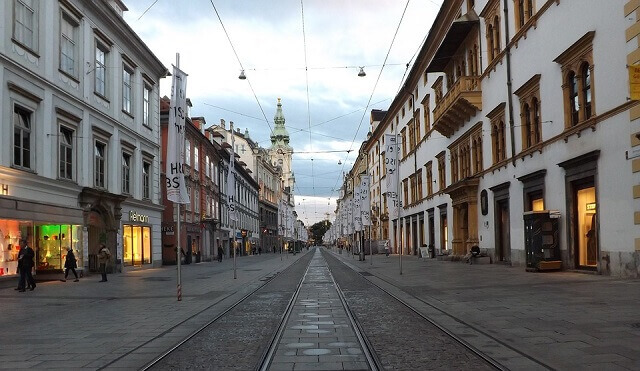
The most important places in the Old Town include the Main Square (Hauptplatz), where the statue of Archduke Johann of the House of Habsburg, who lived in the city in the 18th and 19th centuries and contributed to its industrial development, is located. Important buildings are the Town Hall (Rathaus) built in the 19th century, the Luegg Haus from the 17th century, and the ancient Franciscan Church (Franziskanerkirche) west of the main square.
In addition, in the Old Town area, there are several museums such as the Graz Museum (Stadtmuseum Graz), a museum about the composer Robert Stolz (Robert Stolz Museum), and the European Armoury Museum, which we will elaborate on later.
The Castle Hill and the Famous Clock Tower
The central symbol of Graz and one of its most popular attractions is undoubtedly the green hill located right in the heart of the Old Town. On top of the hill, called Schlossberg, are the remains of the ancient castle that served as the residence of the Habsburg family. In the area where the castle stood, a huge green park was built in the mid-19th century, and in its center are the Clock Tower (Uhrturm), the Bell Tower (Glockenturm), and the Turkish Fountain (Türkenbrunnen). These towers survived after the city’s residents paid a ransom to Napoleon’s army not to damage them.
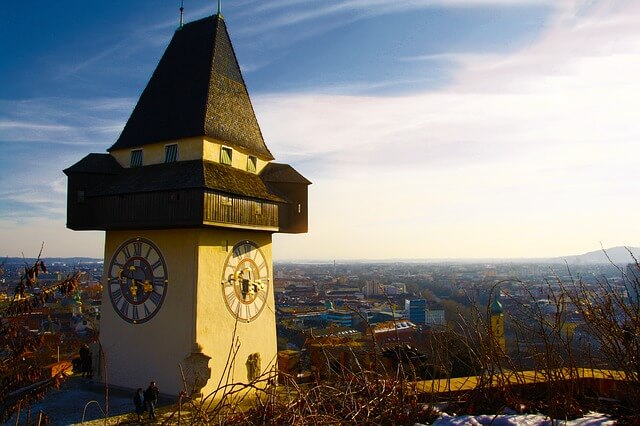
The park offers wonderful views of the Old Town and the more distant neighborhoods of the city. In addition, there are two small cafes, a restaurant, and an event stage where concerts are held in the summer months.
Below the hill is a large system of tunnels that were dug during World War II to protect the city’s citizens from the numerous bombings by Allied aircraft. Some of the tunnels are still accessible and can be visited today. One tunnel was expanded in 2000 and converted into a well-equipped concert hall that can host up to 600 people (called Dom im Berg).
There is also a children’s train that runs through the tunnels, the “Fairy Tale Train” (Die Grazer Märchenbahn). This train travels for about 35 minutes through the various tunnels, which are illuminated with colorful lights and equipped with mirrors and paintings. The temperature inside the tunnels ranges from 8-12 degrees, so it is important to dress accordingly. The ride costs €6.5 for a child under 14 and €8.5 for an adult.
You can reach the top of the hill on foot, but this involves climbing 260 steps or walking a steep path to the summit. Another option is to take the funicular (Schlossbergbahn), which reaches the park at the top from the foot of the hill in a few minutes. The funicular ride costs €2.4 for an adult and €1.2 for a child. In recent years, an elevator (Schlossberg Lift) has also been built, connecting the tunnels under the hill to the park at the top. The elevator ride takes about 30 seconds and costs €1.6 for an adult and €1.1 for a child.
The elevator and funicular depart from the square at the foot of the hill called Schlossbergplatz.
The Highest Spiral Slide in the World
Another exciting attraction on Castle Hill is a spiral slide in the heart of the mountain. The slide is located inside the hill itself and is considered the highest slide of its kind in the world. It reaches a height of 64 meters and its total length is 170 meters. On the way down, you can reach speeds of up to 25 kilometers per hour! More information on the thrilling slide in Graz.
Graz Castle and the Double Spiral Staircase
Graz Castle (Grazer Burg) is located in the eastern part of the Old Town, not far from the city’s cathedral. The castle was built in the 15th century by Duke Frederick V. It served as the seat of the dukes in the 16th and 17th centuries. When Duke Ferdinand II was crowned Emperor of the Empire, he moved to Vienna, and the castle lost its importance. As a result, it remained quite neglected and without any special use. Only in the 20th century did it become the seat of the regional head.
During World War II, the castle was partially damaged by bombings and required extensive renovation. As part of the renovation, two additional buildings were erected next to the original castle structure, and they are now called the New Castle. Today, the castle is used for the government offices of Styria.
You can enter certain parts of the castle and walk around its courtyard. The main attraction in the castle, which can be reached easily and for free, is the double spiral staircase. These stairs are very strange and look like two separate flights of stairs that are partially connected and ultimately lead to the same place.
- Map
Eggenberg Palace – A UNESCO World Heritage Site
About a 40-minute walk west of the Old Town is a magnificent Baroque palace – Eggenberg Palace (Schloss Eggenberg). This is the most magnificent Baroque palace in the entire state of Styria. The palace was designed by the regional governor Hans Ulrich von Eggenberg, and the central motif in its design is the Gregorian calendar.
The palace has 365 windows (like the days of the year), 31 rooms on each floor (the maximum number of days in a month), 24 magnificent guest rooms (like the hours of the day), 52 doors (like the weeks in a year), and 4 towers (like the seasons). Around the palace, there are wonderful and beautifully maintained gardens.
Inside the palace, there are several history and art museums. You can only enter the palace with a guided tour.
Essential Information for Your Visit
Palace Opening Times:
From April 2nd to October 31st.
Tour Times:
Tuesday to Sunday and holidays at 10:00, 11:00, 12:00, 14:00, 15:00, 16:00. Group tours are possible only by prior arrangement.
Garden Opening Times:
- April to October: Every day from 8:00 AM to 7:00 PM.
- November to March: Every day from 8:00 AM to 5:00 PM.
- January 1st only: from 10:00 AM to 5:00 PM.
Palace Entrance Fee:
The entrance ticket for the palace tour also grants admission to 16 other museums throughout Graz and the surrounding area (within 24 or 48 hours of purchase). You can see the full list here.
- Adult: €18
- Pensioner: €15
- School student: €8
- Family (2 adults + children under 14): €34
- Child under 6: Free
Garden Entrance Fee:
- Adult: €3.5
- Child: €2
- Official Website
- Address: Eggenberger Allee 90, 8020 Graz
- Map
Murinsel – Island on the Mur River
The island on the Mur River (in German, Murinsel) is an artificial island floating in the middle of the rushing Mur River. The island was planned and designed by the artist Vito Acconci after Graz was chosen as the European Capital of Culture in 2003. The shape of the island resembles a giant soup bowl. Two bridges connect the river banks to the island, allowing passage from one side to the other. In the center of the island, there is a kind of amphitheater for performances. In addition, there is a café and a small playground for children.
Main Museums:
The Styrian Armoury – The Largest in the World
The Armoury, located in an impressive ancient building in the heart of the city, is the largest in the world! This museum houses about 32,000 weapons, suits of armor, and various armaments that were used for battles or military parades.
The reason there are so many ancient weapons in Graz is that between the 15th and 18th centuries, Styria was a real battlefield. The residents of the area and soldiers from all over the empire had to fight against the Ottoman and Hungarian armies that invaded this area several times. To be prepared for the fierce battles, the soldiers needed many weapons, and for this reason, they kept such a large arsenal within the city.
During World War II, the ancient weapons were moved to hiding places throughout Styria, and thus they were saved from the numerous bombings. After the war, the weapons were returned to the original Armoury building, which remained intact.
Essential Information for Your Visit
Opening Hours:
- November 1st to April 1st: Tuesday to Sunday and holidays from 11:00 AM to 3:00 PM. Admission is by guided tour only (the English tour is at 12:30 PM only).
- April 2nd to October 31st: Tuesday to Sunday and holidays from 10:00 AM to 5:00 PM. Admission is also possible without participating in a guided tour.
- The Armoury is closed on Christmas and at the beginning of the new civil year.
Cost:
- Adult: €11.5
- Child, Student (under 26): €4.5
- Family (2 adults + children under 14): €22
- Child under 6: Free
- Audio guide in English: €3
- Official Website
- Address: Herrengasse 16
- Map
The Graz Art Museum (Kunsthaus Graz)
The building of the Graz Art Museum (Kunsthaus Graz) is perhaps the strangest building that exists today throughout Austria. It’s no wonder, then, that the architects who built it gave it the name “the friendly alien.” The building somewhat resembles a Scottish bagpipe. It looks like a large bag with many small pipes protruding from its roof – very strange.

The museum was established in 2003 as part of the celebrations of Graz’s victory as the European Capital of Culture and quickly became one of the city’s symbols. Inside the museum, various exhibitions of modern art from the mid-20th century to the present day are displayed.
The exhibitions deal with topics such as architecture, design, new media, internet art, photography, and film. All the exhibitions in the museum are changing, so you can always find something new and interesting there.
A glimpse into the museum
Essential Information for Your Visit
Opening Hours:
Tuesday to Sunday, holidays – from 10:00 AM to 5:00 PM.
Guided Tours:
- Guided tours take place on: Sunday at 2:00 PM (English tour), Saturday at 11:00 AM and 3:30 PM (German). Holidays at 11:00 AM (German). You can book a guided tour in advance for another time.
- Architecture tour: Sundays at 2:00 PM (English), Tuesday to Sunday, holidays at 11:00 AM, 2:00 PM, and 3:30 PM (German). You can book a guided tour in advance for another time.
- Closed on Christmas and at the beginning of the new civil year.
Museum Café Opening Hours:
- Monday to Thursday: from 9:00 AM to 11:00 PM.
- Friday and Saturday: from 9:00 AM to 1:00 AM.
Cost:
- Adult: €11.5
- Pensioner: €9
- Student: €5
- Family (2 parents + children under 14): €22
- Child under 6: Free
- Audio guide: €3
- Official Website
- Address: Lendkai 1, 8020 Graz
- Map
Arnold Schwarzenegger Museum
There is hardly anyone who does not know Arnold Schwarzenegger. The small museum located in the village of Thal, near the borders of the city of Graz, is actually Schwarzenegger’s childhood home. The museum presents the life and work of the talented man and provides a glimpse into the world of the most famous Austrian in the world (in a positive way, of course).
Essential Information for Your Visit
Opening Hours:
- Summer: March to October, Monday to Sunday from 10:00 AM to 6:00 PM. Last admission at 5:30 PM.
- Winter: November to February, Monday to Sunday from 10:00 AM to 5:00 PM. Last admission at 4:30 PM.
Entrance Fee:
- Adult: €8.9
- Children (5-14): €3.9
- Guided tour: €10
- Audio guide in English/German: €2
- Official Website
- Address: Linakstraße 9, A-8051 Thal
How to get to the Schwarzenegger Museum?
You can reach the museum by public transport from the center of Graz. From Jakominiplatz in the heart of the city, take bus number 40 and get off at the Gösting stop. From there, it’s a short walk to the Daungasse/Wasserturm stop. At this stop, take another bus, number 48, to the Thalersee stop (a small lake) and then walk along the path that leads towards the golf course. From there you will see the signs directing you to the museum.
- Map
Shopping in Graz
Whether you are coming for a short visit or for several days, it’s nice to combine history and scenery with shopping for brands and bargains. Throughout the city, there are several large shopping malls worth knowing. We have chosen the three most recommended ones:
Shopping City Seiersberg
In the suburbs of the city is a huge shopping complex, the largest in Styria and the third largest in all of Austria. The shopping city is divided into 5 shopping centers with about 180 various shops such as Calzedonia, Bershka, Mango, Palmers, Orsay, Primark, Zara, and more.
- Opening hours: Monday to Friday from 9:00 AM to 7:30 PM. Saturday from 9:00 AM to 6:00 PM. Sunday closed.
- Official Website
- Address: Shopping City Seiersberg 1/9, 8055 Seiersberg
- How to get there by public transport? From the center of Graz, at Jakominiplatz station, take line 32 to Seiersberg. From there, take line 78 which reaches the entrance to the shopping city. Another option is to take tram number 5 to its last stop called Puntigam and from there change to bus number 78.
- Map
CityPark Graz
This mall was the first to be established in Graz and is located not far from the Old Town. The mall has about 100 shops with brands like Palmers, H&M, Tom Tailor, Nanu-Nana, Orsay, Douglas, Humanic, Müller, and more.
- Opening hours: Monday to Friday from 9:00 AM to 7:30 PM. Saturday from 9:00 AM to 6:00 PM. Sunday closed.
- Official Website
- Address: Lazarettgürtel 55
- How to get there by public transport? Bus line number 35 goes from Jakominiplatz station to the mall. Get off at the Kreisverkehr Fabriksgasse stop. Bus lines 31, 32, 33 also depart from Jakominiplatz station and arrive near the mall. Get off at the Lissagasse stop. Line 39 departs from Jakominiplatz and arrives at the Karlauer Kirche/CITYPARK stop.
- Map
Kastner & Öhler
In the Old Town, not far from the beautiful Schlossberg hill, there is a huge and well-kept department store. This store has clothing for women, men, and children, cosmetics, housewares, gifts, and more. The selection is large and the quality is definitely good.
- Opening hours: Monday to Friday from 9:30 AM to 7:00 PM. Saturday from 9:30 AM to 6:00 PM. Sunday closed.
- Official Website
- Address: Sackstraße 7-13
- Map
Public Transportation
Public transport in Graz is very efficient and has a very modern bus and tram system that also operates late at night (the night service is on weekends and holidays).
The most basic ticket is for one hour, during which you can ride as many buses and trams as you want in the city center area (zone 101). You can, of course, purchase a ticket for 24 hours, 72 hours, a week, etc.
You can purchase tickets at the following places:
- Directly from the bus driver (a one-hour ticket or a 24-hour ticket).
- Ticket machines on the trams (a one-hour ticket or a 24-hour ticket).
- Ticket machines at bus and train stations – Hauptplatz, Jakominiplatz.
- At the small kiosks called Tabak/Trafik (a pack of 10 tickets, weekly and monthly tickets).
Please note: During the summer, children up to the age of 15 can travel on public transport for free. In addition, if you purchase a 72-hour ticket, there is a benefit of free travel for two children up to the age of 15 when they travel together with the ticket holder. The 72-hour ticket also provides discounts on admission to attractions in the city.
Unfortunately, Google Maps does not work in conjunction with public transport in Graz, so you have to download a separate app to see the timetables of the public transport lines and plan your route efficiently and simply. The most popular app is called Quando Graz.
You can use the city’s interactive map to navigate between the various attractions.
The Weather in Graz
The weather in this area is sunnier than in Vienna or Salzburg and also a little less rainy. In winter, temperatures range from 0 to 5 degrees, and in summer, temperatures reach 25 degrees during the day. On top of Schlossberg hill, it may be cooler because the hill is exposed on all sides. It is recommended to dress in layers and bring clothing suitable for wind and rain.
Recommended Hotels in Graz
Throughout the city, there are many very nice hotels and guesthouses. If you are coming to the city and plan to sleep there, you should check out the following hotels and guesthouses:
- Augarten Art Hotel – A 4-star hotel located near the city center. The hotel focuses on art and has many works of art inside. The hotel includes an indoor pool, a sauna, and a fitness room. The hotel has large rooms and apartments that are also suitable for families. Click here for photos, reviews, and booking.
- Roomz Graz – A modern hotel in the city center. The hotel rooms are modern and there is a good restaurant on site. Click here for photos, reviews, and booking.
- Hotel Gollner – A few hundred meters from the Graz Opera House is this modern hotel. It is a 4-star hotel with beautifully designed rooms and good service. Click here for photos, reviews, and booking.
- B&B Graz – The guesthouse is located about 10 minutes from the Old Town. The rooms are suitable for a couple, 3, 4, or 8 people. The rooms are quiet, the staff is friendly, and there is an option for breakfast (at the nearby cafe). Click here for photos, reviews, and booking.
- Das Weitzer – This hotel is one of the most famous in the city. It is particularly suitable for a trip around the Old Town because it is very central and close to the city’s important sites. The hotel rooms are beautifully designed and are definitely well-equipped. The hotel has a fitness room and a sauna. Breakfast is served in the hotel’s magnificent dining room. The Graz synagogue is down the street, a short walk from this hotel (a 5-minute walk). Click here for photos, reviews, and booking.
If you haven’t found a hotel here that meets your requirements, you can search among many other hotels in the comprehensive database of the Booking.com website. Click here for comprehensive information on the other hotels in the city.
How to get from Vienna to Graz quickly by public transport?
The distance between Vienna and Graz is about 200 kilometers, and the travel time between the cities is about two to two and a half hours. You can easily get from Vienna to Graz by public transport. There are frequent trains and buses that operate every day and connect the cities.
- Train: The fast regional train (marked as RJ) to Graz departs every hour (10:58, 11:58, 12:58, etc.) from Vienna’s main train station (Hauptbahnhof) and arrives at the main train station in Graz. The train journey takes about two and a half hours and the cost of the trip is €39 one way. You can see the updated schedule and book tickets in advance on the official website of the railway company.
- Please note: On Friday or Sunday evenings, it is advisable to book tickets in advance as the train may be crowded because people are returning home from Vienna or arriving there for the start of the work week.
- Bus: The bus company Flixbus operates a frequent line that departs from the Vienna Felberstrasse station, near Vienna’s western train station (Westbahnhof). The bus arrives in the center of Graz and stops at the Girardigasse station, which is its final stop. The bus departs every hour (12:30, 13:30, 14:30, etc.) and the journey takes two and a half hours – like the train. The cost of the trip is between €12 and €22 one way.
- Please note: You must book your tickets in advance and present them to the driver when boarding the bus.
- Booking tickets in advance is done on the official website of the Flixbus company.
Other Essential Information
- Official City Website
- Address: Graz
- Map

